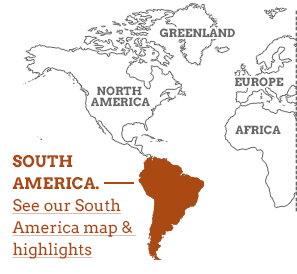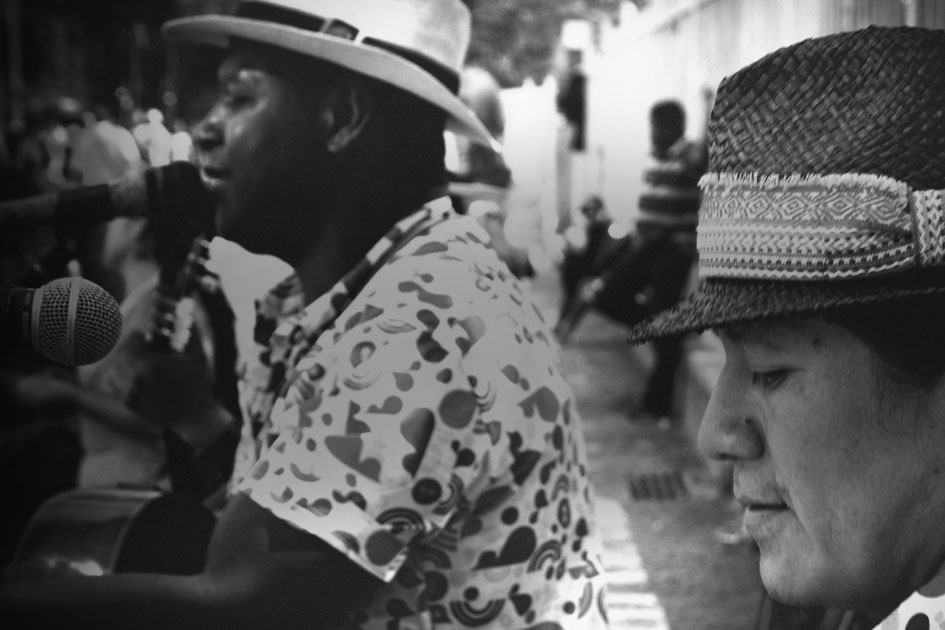South America travel guide

Forget South America's mass market tourist clichés: sipping caipirinhas on a beach; pan-piping Peruvians; Carnival hedonism in Rio. Even if you think you know this vast continent of contrasts, you probably don't know the half of it. Our South America travel guide will pick out justly renowned highlights – the Inca Trail, Patagonia, Galapagos, Iguazu, the Amazon – each a global draw precisely because they're fantastically unlike anywhere else on earth. But we'll also shine a light on more off-the-beaten track places that will remain with you forever if you go.


meet a continent cradling the world's driest desert and largest jungle, alongside some of its most awesome volcanoes and iceberg-filled fjords.![]()

Chile's Atacama, the world's oldest and driest desert – yet dotted with snow-capped peaks and jetting geysers. In Bolivia, marvel at the high-altitude Andean setting of the vast Lake Titicaca. Discover Colombia's history-soaked Caribbean coast, the vibrant hill villages of mainland Ecuador, or Guyana's 'Lost World' wildernesses. South America's secret half and famous half make a breathtaking whole.
South America is/isn't...
South America is...
a stunningly diverse mix of unforgettable nature and culture.
South America isn't...
a group of similar countries.
Ecuador & Galapagos tailor made tour
Private in-depth tour of Ecuador and The Galapagos
From
£6800 to £7900
22 days
ex flights
Peru 2 week tour
Lima, Colca, Titicaca & Machu Picchu in a customisable tour
From
£2065
14 days
ex flights
Small group adventure vacation to Patagonia
Explore the spectacular wilderness and mountains of Patagonia
From
£4900
20 days
ex flights
Brazil vacation, tailor made
Wildlife & culture roundtrip through Brazil, all tailormade
From
€4795
23 days
ex flights
Patagonia 5 day adventure vacation
Torres del Paine, El Calafate and Perito Moreno Glacier
From
US $1310 to US $1660
5 days
ex flights
What we rate & what we don't
Underrated
Atacama
The world's driest and oldest desert is a 1,000km-long plateau of unique otherworldly beauty – a place of salt flats and emerald lakes, ancient lava fields and far horizons, dotted with 6,000m peaks. Atmospheric settlements like San Pedro de Atacama – a lively traveler’s hub – contrast sharply with over 170 ghost towns. In September and October, rare spring rains can spark stunning floral blooms in southern Atacama.
Mainland Ecuador
Picture an area the size of the UK, with steamy Amazon jungle and high Andean páramo, bird-filled cloud forest and mangrove-lined coast. Add majestic colonial cities by snow-capped volcanoes, and the unique evolutionary wildlife lab of Galápagos. Ecuador's culture is equally diverse: colourfully-clad Quichua – descendants of the Incas; lowland tribes steeped in the lore of rainforest and shamans.
Patagonia
Patagonia would be a unique and wonderful country all by itself. Iconic sealife throngs its long coast: whales and elephant seals, albatross and penguins. Inland, lonely steppes mix with jewel-like lakes and epic peaks of national parks like Torres del Paine. Rustic mining and ranch towns complement old Welsh settlements like Gaiman and Dolovon for characterful human presence.
Pantanal
The world’s largest seasonal wetland – and Brazil’s wildlife spotting HQ – is home to almost 700 bird species and around 80 mammals, all easily viewed without the dense vegetation of its far more famous counterpart: the Amazon jungle. Enjoy night treks, canoe rides and horseback hacks to see capybaras, anacondas, monkeys and hyacinth macaws. The Pantanal's Porto Jofre is also the world's top spot to see habituated jaguars.
Rated
Inca Trail
The Inca Trail is a journey and a destination rolled into one, waymarked with natural and cultural rewards. High windswept tundra and humid cloud forest mix with hidden ruins reached by ancient paths. The legendary final destination of Machu Picchu is spectacular but the world of traditional Quechua villages traversed along the way is equally memorable.
Galapagos Islands
Ecuador's island offshoot was a pirate hideaway until its uniquely evolved bestiary provided an evolutionary bonanza for a spellbound Charles Darwin in the 19th century. The landscape – forest, smoking volcanic features, sweeping coast – is as breathtaking as its wildlife that shows no fear of humans – from seals and penguins to giant tortoises and salt-snorting iguanas. Each of the Galapagos Islands offers its own varied geography and ecology.
Amazon Rainforest
Manaus is the base for the northern forest, including the wildlife and pristine jungle environment of Jaú National Park. Cruise past tropical archipelagos, looking for pink river dolphins and giant otters. Or encounter native culture canoeing to Yanomami and Tukano villages. In the southern forest, spot some of the 550 bird species and multiple types of monkey, as well as giant capybaras grazing the riverbanks.
Iguazu/ Iguaçu Falls
Straddling the Argentina-Brazil border, Iguazu, the world's finest cascades stretch 3km and tower higher than Niagara. There are over 270 falls, and you’ll need to border-hop for the full experience. The Brazilian side has rainforest walks and catwalks above the cascades, while Argentina allows you to cruise upriver on a zodiac – navigating rapids to reach the Devil’s Throat Canyon.
Overrated
Drug tourism
Coca leaves are an important traditional crop in countries like Bolivia - a mild stimulant and excellent for altitude sickness. But it also makes the vile, weirdly glamorised drug cocaine. La Paz’s cocaine bar draws tourists, as do cocaine-themed drug tours in the Amazon. Please avoid. They are not only illegal but take money away from legitimate and far worthier initiatives.
All-inclusive Brazilian resorts
Brazil's vast coastline is fringed with spectacular beaches, but for years visitors opted for famous city beaches like Rio's, leave the idyllic secluded strands to beach bums. Now, all-inclusive resorts are springing up in places like Ceara, Bahia and Rio's Green Coast, which aim to keep visitors in the resort rather than out contributing directly to often struggling local communities. Avoid.
Orphanage volunteering
It sounds like a wonderful and worthy cause – but travelers are waking up to the fact that all may not be as ethical as it seems. A revolving door of short-term, unqualified volunteers mean that the children – many of whom may have emotional or mental problems – are abandoned again and again. Worse – when orphans become a “business” thanks to the availability of travelers’ cash, fake orphanages may be set up to lure well meaning volunteers in. Nasty stuff.
Fake culture
Handmade crafts are brilliant mementoes – but they're also a target for fakers keen to get gringo dosh for mass produced tat. Ditto fake 'indigenous' sites such as the floating reed island village in Lake Titicaca. There is nothing wrong with setting up replica sites as a demonstration of traditional culture - as long as visitors are told this, and aren't surprised to discover the 'inhabitants' all leave at the end of the day.
Food, shopping & people
Eating & drinking in South America
Forget the hipster hype; quinoa is a tasty, protein packed Andean grain, sacred to the Incas.
Giant king crab is a treat from Patagonia's cold southern oceans.
Carnivores will love herb grazing, flame grilled, Patagonian lamb as well as barbecued Argentine/Brazilian beef.
Compare superb Chilean wine from Colchaqua, Maipo, Aconcagua and Elqui with Argentinian gems from Mendoza, Salta and Jujuy, San Juan and La Rioja.
Spirit lovers can compare Brazilian cachaca with pisco from Peru or Chile.
People & language
South America mainly speaks Spanish, complemented by Portuguese-speaking Brazil and the English/Dutch/French speaking Guyanas! But shared language doesn't mean shared character. Chileans are, unsurprisingly, quite different to Argentinians, Bolivians from Peruvians, and Ecuadorians from Colombians. Add hundreds of indigenous peoples, each with their own rich traditions, from Inca-descended Quechua to African-influenced Bahia, and Amazon tribes barely touched by the modern world, and South America starts to look less like one big Latino mass, and far more complex and colourful.


Despite the name, Panama hats come from Ecuador. Strong and flexible, they can hold water – and be rolled up to pass through a ring.
![]()

Our top trip
Ecuador & Galapagos tailor made tour
Private in-depth tour of Ecuador and The Galapagos
From
£6800 to £7900
22 days
ex flights
Tailor made:
This trip can be tailor made throughout the year to suit your requirements
This trip can be tailor made throughout the year to suit your requirements
Travel Team
If you'd like to chat about South America or need help finding a vacation to suit you we're very happy to help.
1-866-821-6866
Call toll free
Calling from outside the USA
Gifts & shopping
Authentic Panama hats from Ecuador are easily-packed and very useful.
Shawls/ponchos/jumpers made from alpaca are soft and very warm.
Watch out for shoddy fake 'native crafts'. Buy from local makers in the actual native regions or ask about bona fide specialist shops, such as Amoa Konoya in Sao Paulo, which sells work by 60 Brazilian tribes.
Beautiful jewellery is widespread and distinctive, such as Chile's lapis lazuli pieces.

Contrary to appearances, Chile is not the longest country in the world - Brazil is! It stretches 4,395km north-south, borders ten nations and spans three time zones.![]()

How much does it cost?
Plate of curanto in Chiloé (Chile): £6
Authentic Panama hat (Ecuador): £15 - £35
Entrance to Iguaçu Falls (Brazil/Argentina): £13
Torres del Paine Refugio with breakfast (Patagonia): £60
Budget train journey from Machu Picchu to Cuzco (Peru): £34
Wandering among South America's Scribes
South America inspired two of the most acclaimed travel journals of recent decades, with the 1970s publication of Paul Theroux's Old Patagonian Express and Bruce Chatwin's In Patagonia. More recently, Hugh Thomson has written with gusto about ancient and modern Peru in books like The White Rock and Cochineal Red.
Read more






































